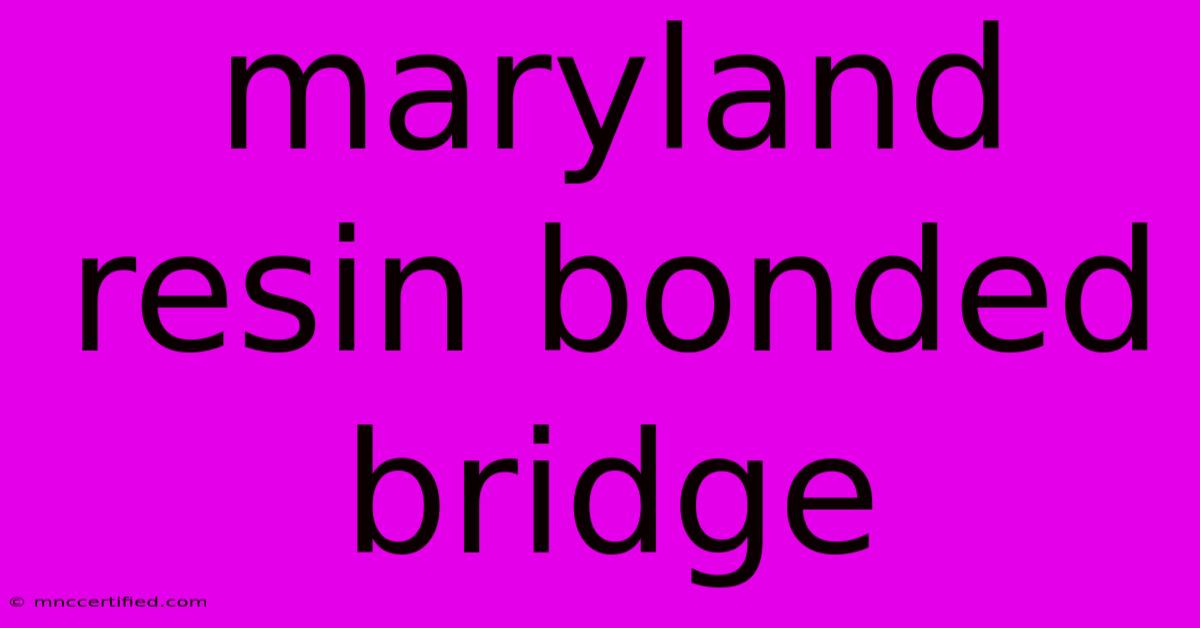Maryland Resin Bonded Bridge

Table of Contents
Maryland Resin Bonded Bridges: A Comprehensive Guide
Maryland Resin Bonded Bridges are a popular and increasingly sought-after solution for repairing damaged or missing teeth. This minimally invasive procedure offers a more conservative and aesthetically pleasing alternative to traditional bridges and dentures. This guide delves into the specifics of Maryland resin bonded bridges, outlining their benefits, drawbacks, and the procedure itself.
What is a Maryland Resin Bonded Bridge?
A Maryland Resin Bonded Bridge is a type of dental bridge designed to replace one or more missing teeth. Unlike traditional bridges which require significant preparation of adjacent teeth, a Maryland bridge uses small, wing-like porcelain or composite resin attachments that are bonded to the inner surfaces (lingual surfaces) of the abutment teeth—the teeth on either side of the gap. These "wings" are bonded securely using a special dental resin, holding the pontic (artificial tooth) firmly in place.
This minimally invasive approach preserves more of the natural tooth structure, making it a preferred choice for patients who want to avoid extensive tooth preparation.
Benefits of Maryland Resin Bonded Bridges
- Minimally Invasive: Requires less tooth preparation compared to traditional bridges. This preserves more of the natural tooth structure.
- Aesthetically Pleasing: Maryland bridges are designed to blend seamlessly with natural teeth, providing a natural-looking and aesthetically pleasing restoration. The porcelain or composite resin material closely matches the color of your existing teeth.
- Cost-Effective: Generally less expensive than traditional bridges due to less extensive preparation and lab work.
- Shorter Procedure Time: Often requires fewer appointments than traditional bridge procedures.
- Strong and Durable: Modern materials and bonding techniques result in strong and durable bridges that can last for many years with proper oral hygiene.
Drawbacks of Maryland Resin Bonded Bridges
While offering numerous advantages, Maryland bridges also have certain limitations:
- Not Suitable for All Cases: They are not suitable for patients with severely damaged or weakened abutment teeth, significant bite problems, or those with high levels of bruxism (teeth grinding).
- Increased Risk of Debonding: Although modern adhesives are very strong, there's a slightly higher risk of the bridge debonding (coming loose) compared to traditional bridges, especially with excessive force or poor oral hygiene.
- Limited Strength: They might not be as strong as traditional bridges, particularly when used to replace multiple teeth or in areas under high biting pressure.
- Not Ideal for Posterior Teeth: Maryland bridges are generally more suitable for anterior (front) teeth due to the lower biting forces in these areas.
The Maryland Resin Bonded Bridge Procedure
The procedure typically involves these steps:
- Examination and Assessment: Your dentist will perform a thorough examination to assess the suitability of a Maryland bridge for your specific case. X-rays and impressions might be taken.
- Preparation: Minimal preparation is required. The inner surfaces of the abutment teeth are lightly etched to improve bonding.
- Impression Taking: An impression of your teeth is taken to create a custom-made bridge in a dental laboratory.
- Temporary Bridge (Optional): A temporary bridge might be placed to protect the prepared teeth until the permanent bridge is ready.
- Bridge Cementation: Once the custom-made bridge is ready, it's carefully bonded to the prepared teeth using a strong dental resin.
- Follow-up Appointments: Regular follow-up appointments are crucial to monitor the bridge's condition and ensure proper fit and function.
Choosing the Right Option: Maryland Bridge vs. Traditional Bridge
The decision between a Maryland bridge and a traditional bridge depends heavily on individual circumstances. Factors considered include the health of abutment teeth, the location of the missing tooth(s), and the patient's lifestyle. A consultation with a qualified dentist is essential to determine the most suitable option.
Maintaining Your Maryland Resin Bonded Bridge
Proper oral hygiene is essential for the longevity of your Maryland resin bonded bridge. This includes:
- Regular Brushing and Flossing: Gentle brushing and flossing are crucial to prevent plaque buildup and gum disease.
- Regular Dental Checkups: Regular visits to your dentist for professional cleaning and checkups are important to detect any potential problems early.
- Avoiding Hard Foods: Avoid biting down on excessively hard foods that could damage the bridge.
Finding a Qualified Dentist in Maryland
Finding a qualified and experienced dentist is crucial for a successful Maryland Resin Bonded Bridge procedure. Look for dentists with a proven track record in restorative dentistry. Reviews and testimonials can help in making an informed choice. Don't hesitate to ask potential dentists about their experience with Maryland bridges and their success rates.
This comprehensive guide provides valuable information about Maryland Resin Bonded Bridges. However, it’s crucial to consult with a dental professional for personalized advice and treatment planning. Remember that individual results may vary.

Thank you for visiting our website wich cover about Maryland Resin Bonded Bridge. We hope the information provided has been useful to you. Feel free to contact us if you have any questions or need further assistance. See you next time and dont miss to bookmark.
Featured Posts
-
Loctite 2 In 1 Seal And Bond
Nov 30, 2024
-
My Word Is My Bond Crossword
Nov 30, 2024
-
Notary Bond Washington State
Nov 30, 2024
-
Oh Bondad Tan Infinita Letra
Nov 30, 2024
-
Shedeur Sanders 28 Year Record Broken
Nov 30, 2024